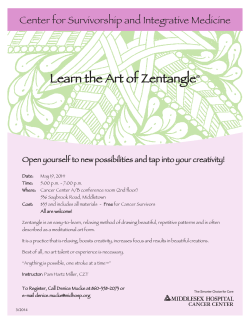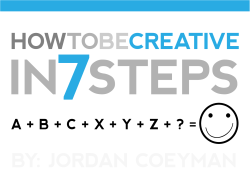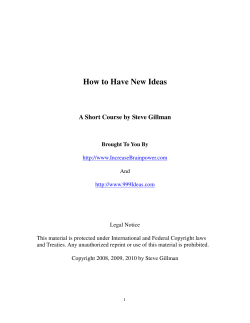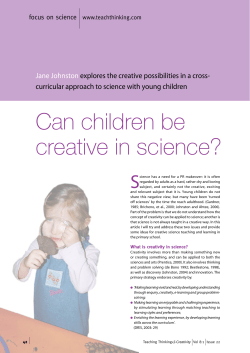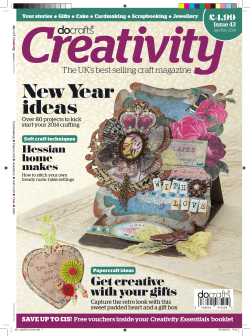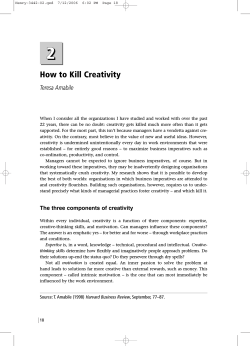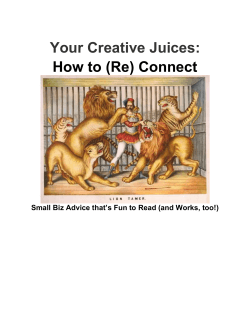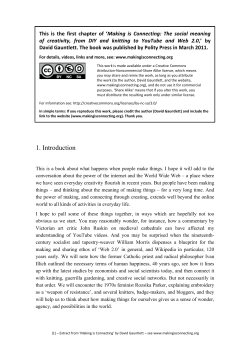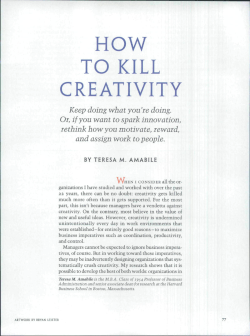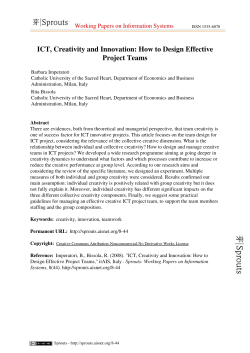
The creative researcher Tools and techniques to unleash your creativity
The creative researcher Tools and techniques to unleash your creativity Practical information and advice for researchers about creativity in a research environment Dr Kevin Byron www.vitae.ac.uk/researcherbooklets Contents Section 1: Introduction 3 Section 2: Creativity versus innovation 3 Section 3: The nature of creativity 4 3.1 3.2 What is creativity? 4 Who is creative? 4 Exercise 1: Where do you stand? 5 3.3 Why is creativity important? 6 3.4 When is creativity required? 7 Exercise 2: Opening up a research question 9 Section 4: Nurturing creativity 4.1 4.2 4.3 10 Risk taking 10 Tolerance to ambiguity 11 Exercise 3: Experiencing insights 11 Trust in intuition? 12 Exercise 4: Trust in intuition? 12 4.4 Visualisation 13 4.5 Work/Life balance 13 Section 5: A Framework for creative problem solving Exercise 5: Associative thinking 5.1 14 14 ENTRE 15 Enquire 16 5.2 Transform 16 5.3 Realise 17 Section 6: Top ten tips for nurturing creativity Answers to exercises 18 19 ‘The creative researcher’ is published by the Careers Research and Advisory Centre (CRAC) Limited. www.crac.org.uk Vitae is supported by Research Councils UK (RCUK), managed by CRAC: The Career Development Organisation and delivered in partnership with regional Hub host universities ‘The creative researcher’ has been edited by Maija Sirola, Vitae Communications and Marketing Manager and Dr Tennie Videler, Vitae Programme Manager: Researchers To order copies please contact Vitae at orders@vitae.ac.uk All material appearing on ‘The creative researcher’ is copyrighted and may only be reproduced with permission from Vitae. Any opinions expressed are those of the writers and do not necessarily reflect those of Vitae. The external links provided to other resources and websites are no responsibility of Vitae. Vitae®, © 2009 Careers Research and Advisory Centre (CRAC) Limited 2 Section 1: Introduction – unleash your creativity The pioneering rocket scientist – Wernher von Braun – once said: ’Research is what I’m doing when I don’t know what I’m doing!’ and anyone grappling with the early stages of a research project will be able to relate to that. Whilst research requires a balance between critical thinking and creativity, there’s no strong correlation between intellectual ability and creativity. Creativity is not something that can be taught directly, and the outcomes of creative thinking are not predictable. Everyone can be (and is) creative. Interestingly we’ll see later that it is creativity that actually fuels progress in research. It’s probably because of the nebulous nature of creativity that von Braun described research as he did. Understanding and developing creativity may not provide us with a better sense of knowing what we are doing when we are doing research, but it can be argued that it may make us more efficient and productive researchers. Undoubtedly, a creative approach is invaluable for other skills associated with research such as communication, influencing, managing, writing, networking and team-working. Although creativity can’t be taught directly, it can be absorbed and ‘the skills for accessing it acquired by osmosis’, through immersion in creative activity with other people. It can also be nurtured through experiential training, through the acquisition and application of tools and techniques, and the practice of attitudes conducive to creative behaviour. This booklet aims to define the nature of creativity – an essential first step in nurturing it – and to introduce some tools and techniques that can be applied in helping to develop a more creative approach to research. Section 2: Creativity versus innovation The terms creativity and innovation are often used interchangeably but we need to be more precise in defining their meaning. Innovation refers to the management of ideas and making original, creative ideas a reality. In the context of research, innovation refers to putting into action any idea that the researcher has. Creative ideas initiate the innovation process but new insights which refine the original idea occur throughout that process. Creative ideas will only be valued if they are seen through to innovation. A thesis or published journal paper are outcomes of innovation processes that started with original, creative contributions by researchers. History tends only to remember innovators – those people who actually do something with their creative ideas. Edison did not invent the light bulb but he was its innovator. Over twenty people invented it before him, going back some eighty years. But he refined it so that it became a practical device and brought it into commercial use by partnering with an electrical distribution company. 3 Section 3: The nature of creativity 5W +1H: What? Where? Who? When? Why? How? is a questioning tool that is used in creative problem solving methodologies. Rudyard Kipling expressed this idea in verse: When? I have six honest serving men They taught me all I knew I call them What and Where and When And How and Why and Who What? How? Where? Why? Who? In this section we’ll use the 5W+1H questioning tool to look at the nature of creativity in a bit more detail, defining what is meant by creativity, what kind of people are creative and why, where and when it can be a useful skill to have. The question of how creativity is nurtured is answered throughout the document. 3.1 What is creativity? Creativity in the context of research can be defined for the purposes of this booklet as: ‘Ideas that are original and useful’. A doctoral thesis or academic paper (reviews apart) should contain original work by the authors and clearly describe the relevance and usefulness of the contribution in a wider perspective. It is important, especially at the beginning of a research project, to reflect on the impact and relevance of the research, no matter how indirect or distant in time this might be. Originality can be further defined as a new combination or connection between ideas. Many original ideas arise when two existing ideas are combined. As well as the actual subject of research, original contributions may appear in the form of new tools and procedures. These contributions can often be taken for granted by research students, but are an important part of the original contribution of a doctorate. We will see later, in the context of this booklet, that original thinking can also be seen as a discontinuity in current thinking that progresses research. In this respect it is important to differentiate between personal creativity and truly original creativity. All our words and actions are to some extent unique and we may consider ourselves to be creative in different aspects of our lives. Original creativity however, is validated by innovation and can be recognised externally as intellectual property. 3.2 Who is creative? The answer to this question is everyone! Creativity is demonstrated in different ways by different people, and at different times. And it will come as no surprise that the ability to solve problems in novel ways is manifested in early childhood. Clearly, the more you know and the more eclectic your knowledge, the greater the potential variety in ideas. However, much of the time when doing research we need to be immersed in the very narrow field of our studies, so there is a balance to be struck in order to incorporate a broader perspective and creative approach to our work. Sometimes research needs to be progressed in a step-wise, adaptive way and at other times we need to be more creative. We may be predisposed to either one of these approaches so it’s useful to identify where we stand on the adaptive-creative scale shown in Figure 1 opposite. 4 Adaptive Where do you stand? more adaptive Creative more creative Figure 1: The adaptive and the creative researcher The extreme adapter: At the far left of the scale, the extreme adapter progresses their research one small step at a time through a measured approach, checking each step, scrutinising every outcome and recording everything in detail. They tend to be very organised, focussed on the task and hard-working; they go through their daily work in a routine way. They are rather conventional in the way they think, tend not to have big ideas and are risk averse. Their work is always likely to progress, but it is unlikely to lead to major breakthroughs. It is not to say that an extreme adapter would not be creative, they just do not habitually access their ‘creative brain’. The extreme creative: At the far right of the scale, the extreme creative tends to be constantly challenging assumptions, trying new approaches and pushing their research in different directions, but they are not to so good at recording the outcomes of their forays into the unknown, unless they obtain a good result. They are quite disorganised, do not like to conform, dislike routine, love to take risks but are poor time managers. They do occasionally have great ideas that can accelerate the progress of their research – assuming they do something about making it happen. Both approaches have their advantages and disadvantages depending on the nature and stage of the research. Once you have identified where you fit on the adaptive-creative scale, you can work on acquiring the skills you are lacking in order to become a more rounded researcher. Exercise 1: Where do you stand? Bearing in mind the characteristics of both extremes, where do you think you fit on the adaptive and creative scale? If you think you lie towards the adaptive end of the scale, the idea-finding tools and creative behaviours described later will be of most value. If you identify more with the creative end of the scale, the techniques on shaping a creative challenge will be of more value. It is also worth observing your supervisors’ and other colleagues’ approaches to research. Most research is collaborative and understanding differences in style, and making the most of these differences, can be mutually rewarding and lead to a greater flexibility in your own approach to research. 5 Section 3 Research is often viewed as a process of unpunctuated, continuous progression. This is most evident in reviews that describe retrospectively the evolution of a research field over a decade or so. In these accounts the false starts, delays, null hypotheses and unrealised speculations tend to be ignored at the expense of a narrative describing continuous progression. Even the great ‘Eureka’ insights by individuals that accelerate progress tend to be understated in these reviews. This continuity in the progress of research can be illustrated by looking at the Sigmoid curve shown in Figure 2. The curve represents a smooth transition through three stages of growth: infancy, rapid development and maturity. These stages are described in more detail below: Research progress 3.3 Why is creativity important? Next development Maturity Rapid development Infancy Effort (time) Figure 2: The Sigmoid curve of research progress Stage 1 Infancy: This is when a new field of research opens up, otherwise known as basic or blue skies research. Progress is slow because ideas are speculative, there will be little evidence supporting theories, and few people will be working on it. Funding bodies may not be convinced that the research could lead to something useful. Stage 2 Rapid development: Here the new ideas have started to gain acceptance, results have been verified and progress accelerates. Funding is easier to obtain because the chances of success are seen as much higher. Stage 3 Maturity: At this final stage new anomalies or gaps in knowledge appear that can not be explained by the existing model or theory. This launches a new trajectory of basic research that aims to accommodate these anomalies. These discontinuities represent the original contributions. Such breakthroughs, small or large, are not predictable from the knowledge available at the time: they are the result of creative thinking. So when looking at the importance of creativity, we can see that it is the driving force of progress. A doctoral thesis may describe two or three of these discontinuous steps as the author’s original contributions to the field of research. 6 Research progress During the transition between development curves (shown in orange and green in Figure 2) there is usually much controversy between competing models or theories. The gap between the two curves represents a discontinuity that often requires huge creative shifts. But these gaps or transitions are not the only places where the creativity of researchers is needed. If we magnify just one small part of the smooth curve of Figure 2, we can see that in actual fact there are many more discontinuities that contribute to progress. This is illustrated in Figure 3. Next development Creative steps Delays Setbacks Effort (time) Figure 3: Continuous versus discontinuous development 3.4 When is creativity required? All stages of research require some measure of creative thinking and we will see in this section that creative thought can be initiated by a series of appropriate questions. Depending on what stage of the research you are at, you can ask yourself different types of questions. Some questions require critical appraisal, others are speculative and open-ended, requiring a more creative approach. The enquiry wheel in Figure 4 illustrates the various stages of research. This wheel was based on the views of scientists, and some, if not all, of the stages will apply to your own field of research. The scientific community Observing Defining the problem Communicating the findings Society Reflecting on the findings Questions Interpreting the results Investigating the known Carrying out the study Figure 4: The enquiry wheel Forming the question Articulating the expectation Harwood, W.S., Reiff, R., & Phillipson, T. ‘Voices from the frontline: Scientists’ conceptions of scientific inquiry’. J.Chem Edu (2004) In Figure 4 the practice of research is not represented as a linear activity that follows distinct steps in a specific way. It can start at different points on the wheel and it may be necessary to jump across the wheel at times to reappraise assumptions and hypotheses or redesign the research methods. Questions are at the hub of this wheel and progress can be helped or hindered by the way the questions are framed and the use of convergent or divergent thinking. Divergent thinking is associated with determining goals, exploring possibilities and generating ideas. In other words any questions that go beyond the remit of a statement about a problem or challenge. Convergent thinking concerns decision making, analysing options and planning actions. Here the questions concern only what is known about or bounded by the problem or challenge in order to arrive at a decision or a conclusion. In practising the tools and techniques of creativity, it is essential to separate these two approaches. 7 Section 3 When we want to generate new ideas, initially it is essential to exercise divergent thinking before embarking on any convergent thought. The benefit of separating these processes is that all ideas can be gathered without being censored by premature judgment. We can embark on the different stages of a research project by applying different questioning techniques. At the start of a research project we have an open-ended question and we can help contextualise the research by using the 5W+1H questioning tool that we looked at earlier. For example: What? (eg What does the research aim to achieve? What does success look like?) Who? (eg Who does the research affect? Who are the stakeholders?) Where? (eg Where else is the research taking place?) When? (eg When will the research be carried out? When will there be benefits?) Why? (eg Why is the research important?) How? (eg How will the research be conducted (methods)?) The Why? question has special significance in helping to abstract a research question and make it more accessible to creative possibilities. By way of an example, let’s look at the following research question: ‘How could researchers improve their presentation skills?’ The word ‘presentation’ is often associated with the use of PowerPoint or other similar visual aids. So as part of our planned research we might work on improving PowerPoint skills and watching other people’s presentations for further ideas. We could then come up with some results that lead to guidelines for researchers to become better presenters. If we take a more creative approach, we could ask ‘Why?’ The answer can then be re-framed as a new research question: Original research question: ‘How could researchers improve their presentation skills?’ Ask ‘Why?’: ‘Why should researchers improve their presentation skills?’ Answer: ‘In order to become better communicators of their research’ Re-framed research question: ‘How could researchers become better communicators?’ This now looks like a richer research question that gets closer to the heart of the issue. It could be argued that it involves a wider study and more work, but the outcomes will address the new question and also answer the first one. Tackling the first question alone might not be addressing the root cause of the issue. 8 Exercise 2: Opening up a research question If you are grappling with an aspect of your research that needs new thinking, try using the abstracting method shown in the example at the bottom of page 8 to generate and focus your ideas. Here is how you can approach it: 1 At the top of a blank sheet of paper, write down your challenge in the form of a question. 2 Ask ‘Why’ to the question and write down the answer. 3 Re-frame the answer as a new question. 4 Brainstorm the new associations that come to mind with this new question. 5 Select an idea or combination of ideas from the list using originality and practicality as criteria and plan the next stage of your research where this new idea can be applied. This process can be repeated with the new question if you want to delve even further into the problem. 9 Section 4: Nurturing creativity In terms of effort and time put in, research in the early stages (see Figure 3) is relatively inefficient. Delays can be caused by factors such as allocation of resources and training time. Productive thinking also takes time. This is partly due to the study time necessary to understand relevant concepts as well as to the time required to keep abreast of published work. It is often not openly acknowledged but creative insights can also be the source of delay. In this section we will focus on nurturing creative behaviours to make the most of this creative time. Graham Wallas identified four main stages of creative thinking in 1926: Stage 1: Preparation – Assessment and clarification of a challenge that requires creativity. Stage 2: Incubation – A period of unconscious activity facilitated by conscious disengagement. This can take many days. Stage 3: Insight – The ‘Eureka’ moment where a breakthrough idea emerges into conscious awareness. This sometimes occurs by virtue of Stage 2, away from the place where the challenge was identified. Sometimes it occurs in a dream. Stage 4: Elaboration – The commencement of ‘Innovation’ where the original idea is refined, shaped, communicated and put into practice. Each of these stages can take varying, maybe extensive amounts of time, but it is the transition between stages 2 and 3 that is worth focussing on. The incubation period before an insight can sometimes be quite brief. For example it took Sir Alex Jeffries only thirty minutes after examining an X-Ray film of a fragmented DNA sample to realise its potential for what we now know as DNA fingerprinting. This Eureka moment also represented a creative connection between two completely different fields (genetics and forensics). There are numerous examples of insights occurring during a dream. The most recorded song in history – ‘Yesterday’ – came to Sir Paul McCartney spontaneously on waking up one morning. Similarly the poem Kubla Khan by Alfred Lord Tennyson was inspired in a ‘dream-like’ state A great deal of neuro-scientific research has been carried out on the insight moment by giving subjects exercises that require a creative approach and measuring changes in their EEG patterns. The measured changes have been observed in high frequency theta waves prior to an insight. This occurs during the period when the subject has ‘relaxed back’ from solving the problem by trial and error and is consistent with what Wallas described as incubation. In the following sections we will look at behaviours that are conducive to achieving creative insights and that elusive Eureka moment. 4.1 Risk taking One of the characteristics of highly creative people is their ability to take risks. Apart from the risks in dealing with criticism from others, this means dispensing with the security and comfort of existing habits of thought and developing a challenging mindset. One way of nurturing creativity is to observe risk taking in others. By observing how others go about things, we can learn to take risks with our own approach and so adapt our working style. 10 4.2 Tolerance to ambiguity Ambiguity relates to unresolved issues or problems and grey areas. Taking an adaptive approach to find an early resolution tends not to lead to new ideas and is often only a temporary fix. Taking the more creative approach and developing a tolerance to ambiguity allows the problem to remain unresolved for longer. Using Wallas’ creative thinking model, this can mean withdrawing from the problem and trusting in Stage 2 the incubation process. For this to be successful it is important to make sure that the challenge is clearly defined in Stage 1, preparation, otherwise any inspired ideas may turn out to be of little value. Exercise 3: Experiencing insights The next few activities test your creative skills. Try solving these insight problems then reflect on your approach and the difference in ‘feel’ when you are focussed on an analytical or ‘trial and error’ approach as opposed to a more open-ended creative approach. The first 7 are a class of ‘Rebus’ problems that are used in ‘Insight research’. They are forms of wordplay and an example is given first. The number in square brackets refers to the number of words in the solution. Example: ECNALG [2] Answer: Backward Glance 1 BAKED [2] 2 |R|E|A|D|I|N|G| [4] 3 CI II [4] 4 SADDULT JTOURY [4] 5 FLINSEEG [2] 6 PTU [4] 7 GGSE [2] 8 Below are drawings of the end view and the top view of a solid three dimensional object. Inside the dotted square draw what you think the side view would look like. End View Top View 9 Their are four errers in these two sentences. Can you spot what they are and and write them down? 10 How quickly can you find out what is unusual about this paragraph? It looks so ordinary that you would think nothing was wrong with it at all and in fact nothing is wrong, it is just distinctly odd. Side View Afterwards check your answers with those on page 19 11 Section 4 4.3 Trust in intuition? Intuition can be defined as a form of knowledge or experience unaccompanied by conscious, reasoned thinking. Conscious thought uses rationality as a guide and deals with tasks in a linear, sequential way. Intuition works by association and by rules of thumb that are short cuts through repeated association. Intuition is developed by experience but it is not infallible, and short cuts applied inappropriately can lead to misperceptions. In research many new ideas appear to be counter-intuitive until new knowledge is acquired. Therefore we need to check out our assumptions and suspend judgment until other options have been explored. To make the most of our creative skills we need to learn to understand, hone and trust our intuition. Exercise 4: Trust in intuition? Try answering the three questions below with a quick intuitive estimate (limit yourself to 30 seconds) rather than working them out from first principles. Afterwards check your answers with those on page 19 to gauge how much you can trust your intuition! 1 If we had only six brain cells and a pattern of connection represented any number of these six being connected to one or more of the others. How many distinguishable patterns of connection are there? For example, for only three brain cells we would have seven possible patterns of connection shown below. A B A C B A C B A C B A C B A C B A C B C 2 If someone has two children and you know that that one of them is a girl, what are the chances that the other is a girl? 3 90% of the inhabitants of a village have immunity to a certain condition. A new test can screen for whether or not a person has immunity and it gives a result that is correct 90% of the time. If a particular person was screened and the result showed they did not have immunity what is the % chance they actually do not have immunity ? There is more to developing our intuitive skills than first meets the eye. We need to bear in mind that we tend to remember the times our speculations were correct and conveniently forget the times when they were not! One way to check the accuracy of our intuition is to record hunches about research ideas in a daily journal. By checking back, we can begin to identify patterns and a greater sensitivity to the difference between pure guesswork and intuition informed by experience. 12 4.4 Visualisation Doing research involves a great deal of reading and writing. This requires more critical than creative thinking. By practising visualisation techniques we can form mental pictures of the concepts under study and improve our creative thought processes. Visual literacy aids learning and helps nurture creativity. One way of developing visual literacy is to study images and try to interpret them to unlock the creative thinking by artists and designers. Studying images can also help identify analogies that help clarify aspects of research. To appreciate the relevance of visualisation, we just have to look at how much our understanding of abstract quantities relies on visual analogues of the phenomena they record in, for example, spectra and graphs. On a personal level, creating your own images also improves visual literacy skills: drawing and painting can be a relaxing distraction to aid problem solving and stimulate the imagination. As a simple exercise in visualisation how many faces can you see in the image above? Answer: There are three (An older man, an older woman and a young woman). 4.5 Work/life balance To keep up with our busy day-to-day living and to stay on top of things, maintaining a good work/life balance is crucial. It is important to keep stress levels and general health in check. And what is more relevant in the context of research is that when we live in and experience different environments, it facilitates a more creative attitude. Creative ideas do not always arrive when and where we want them. Our minds may be able to escape from the rigours of work, but our unconscious brain carries on, unperturbed by the physical environment. Sometimes ideas occur in dreams. These ideas may be our Eureka moments and can easily escape if they are not recorded. So it is a Creativity thermometer good idea to have a notebook and pen with you to record any ideas that come to you unexpectedly. ‘Burn-out’ Creative behaviour is strongly influenced by our level of emotional engagement. We can define stress as the emotional and physical response to demands put upon us from the outside world. When excessive demands are placed on us this inhibits our creative ability. A lack of motivation has a similar effect. One way of relieving emotional anxiety or boredom is to have a break, take some exercise, meditate, socialise or do something different. Fatigue Reduced alertness Reduced creativity Creative Decisive Alert The rigours of the busy modern workplace tend to push most people beyond their peak performance in terms of creative thinking. To nurture our creativity we need to be aware of how we are coping with the various demands put upon us and practice techniques to minimise any detrimental effects. Figure 5 illustrates how our creative performance is affected by our emotional arousal, when we are fully relaxed and asleep compared to a highly stressed state. Stimulated Frustration Boredom Under involvement Frozen Figure 5: Performance versus demands/emotional arousal 13 Section 5: A framework for creative problem solving This section will provide you with a framework for a more systematic approach to applying creativity tools as well as other ways of generating ideas. This framework has been adapted from the process commonly known as brainstorming, devised some fifty years ago by Alex Osborn and Sid Parnes Exercise 5: Associative thinking By way of introduction to the creative problem solving framework known as ENTRE, here is an exercise in associative thinking, the default method used for generating new ideas. 1 Look at the object pictured right and using your imagination write as many things down that you think it could be (eg part of Stonehenge, a bench, some cricket stumps). See if you can list six or more new ideas in five minutes. Then take a five minute break and continue and see if you can list another four ideas. 2 Now examine the list you have written and note how many of the ideas where you can identify an association you found after applying (albeit unconsciously) some kind of rule (eg “Turn upside down”, “Magnify”, “Minify”, “What might it sound like” etc ). 3 Compare the last four ideas with the first four ideas and try and establish where the really interesting ideas happened. The key points from this exercise are: 1) Brainstorming takes time. Taking a break enables the incubation process which may lead to more ideas that would have been lost if idea selection had taken place too soon. 2) Many ideas emerge as a result of applying unconscious rules to obtain associations, described here as transformations. 3) We tend to use only certain rules habitually. We will have more ideas if we are aware of all of the transformations which are described in the SCAMPER tool later. Other idea-finding tools can also assist in this process. 14 Figure 6 shows the ENTRE framework for creative problem solving. It consists of three stages: enquire, transform, realise. Each stage has two steps: divergent followed by convergent thinking. In the divergent phase options or ideas are generated, and in the convergent phase the ideas are analysed and decisions made about which one to proceed with. Here are some guidelines to help you with divergent and convergent thinking: REMEMBER to always diverge first! Divergent thinking Convergent thinking Suspend judgment Cluster similar statements/ideas Include the obvious Refine and combine statements/ideas Go for quantity Be decisive Avoid editing ENTRE: Creative problem solving Statements that describe the future vision of challenges/problems. Tools: diagnosing, abstracting Idea-finding tools Association SCAMPER Analogy Combining How is acceptance gained? What needs to be done? What resources are required? Transform REalise Find ideas and evaluate Plan for action Co nv er ge Di ve rg e ge er nv Co Di ve rg e ENquire Identify and clarify the challenge One clear statement that gets to the heart of a selected challenge 1. Identify criteria to evaluate ideas 2. Evaluate best ideas by testing against criteria Who does What? How? When? Figure 6: A framework for creative problem solving The following sections look at the three stages of the ENTRE framework in more detail. 15 Section 5 5.1 Enquire One potential danger of conventional brainstorming in teams is to assume that everyone has a common understanding of the challenge when they don’t. This can happen with the most everyday issues so it is worth checking that everyone is in agreement by using the abstracting and questioning tools that we looked at in section 3.4. This stage of identifying and clarifying the challenge is the enquiry stage of the ENTRE framework. When you apply divergent thinking at the enquiry phase, you will end up with a list of different variations on the original challenge statement. To converge to a single statement some criteria need to be identified to compare these variations. Criteria could include time and resources; alternatively you could use the following three questions as criteria to help in the decision-making process: Q1: Q2: Q3: Is this challenge important enough? Do we have sufficient influence to implement the ideas that might emerge? Does this challenge need new ideas to solve it? When the challenge has been clearly defined, then brainstorming can start at the transform stage. 5.2 Transform Having selected the challenge, stage two of the framework, transformation, requires you to list ideas by association that might provide solutions to this challenge. As in the associative thinking exercise we did earlier, remember to extend the time over which this is done and to take breaks and return to find more associations. Another tip for generating new ideas by association is to apply rules of thumb, prefacing each transformation by asking ‘What if?’ There are only seven kinds of transformation summarised in a memorable way with the acronym SCAMPER. This stands for Substitute, Combine, Adapt, Modify (ie Magnify, Minify, Multiply), Put to other uses, Eliminate and Reverse. The SCAMPER tool was first developed by Eberle, Osborn and Parnes. To show how commonplace these transformations are, listed right are some examples, all taken from 26 September 09 issue of the New Scientist magazine. 16 SUBSTITUTE: A 3D animated avatar capable of voice recognition proved to be as good as a human in witness identification experiments. (Brent Daugherty, University of North Carolina) COMBINE: A combination of drugs and electrical impulses enabled rats with severed spinal columns to sprint without re-growing the nerves between the injury and the brain. (Grégoire Courtine, University of Zurich) ADAPT: Robotic insects wings are being built based on adaptations of real locusts’ wings (Adrian Thomas, University of Oxford) MODIFY (Magnify/Minify/Multiply): Tools have been developed which can create 3D models of cities from thousands of photos. (Sameer Agrawal, University of Washington) PUT TO OTHER USES: There are plans in the USA to use the waste heat generated by nuclear reactors for industrial processes such as fertiliser production. ELIMINATE: A genetically engineered mouse lacking a protein that controls a gene connected with obesity, led to a 15% weight loss after six weeks. (Leona Plum, Columbia University Medical Center in New York) REVERSE: Alcohol may be an effective medicine one day for people with brain injuries to help them recover. Animal experiments suggest that relatively low doses of alcohol protect the brain from injury, but high doses increase the risk of death. (Ali Salim of the Cedars-Sinai Medical Center in Los Angeles) To develop the technique further you can find associated questions for each of the SCAMPER prompts. For example for Combine we could ask; What existing ideas can be combined? What about combining different methods? What materials can be combined? What procedures or tasks can be combined? What about a mixture or assortment? Again at the end of the divergent phase, there will be a long list of ideas to be reduced down to the best ideas. You can achieve this in two stages. First by applying general criteria to each idea in turn in the form of the three questions from section 5.1. If the ideas are being shared by a group of people, you can ask each person to vote for their favourite 3–5 ideas as a way of converging. To identify the best idea out of the last few, use specific criteria to compare the ideas and devise a scoring system. Figure 7 shows one way of doing this. This simple example compares new uses for a CD disc using specific criteria: cost, practicality, originality and safety. Solution finding Criteria for selection Criteria for selection 1. 1. Frisbee 3 2 1 1 2. 2. Pizza cutter 3 2 2 1 8 3. 3. Coaster 3 4 2 3 12 4. 4. Bird scarer 2 4 2 2 10 5. 5. Earring 2 1 2 1 6 Score selected ideas: 1 (Low value), 2, 3, 4 (High value). Score selected ideas: 1 (Low value), 2, 3, 4 (High value). Ho ld y lit lity ica na ty st act rigi afe o r S C P O Selected ideas To ta l Pa ss Ho ld Selected ideas To ta l Pa ss New uses for a CD? 7 ✓ ✓ ✓ Figure 7: Selecting the best idea In the event of a tie you need to apply a weighting factor on the most important criteria to help rank the tied ideas. 5.3 Realise After deciding on the idea, the final stage in this process ‘Realise’ concerns how it will be implemented ie the innovation stage. This involves another divergent step to identify resources required, people involved, costs etc followed by an action plan. The experienced researcher will be familiar with the work required to achieve this along the lines of conventional project management methods. 17 Section 6: Top ten tips for nurturing creativity Here are the top ten tips for creative thinking that we have looked at so far. Some can be integrated gradually into your working life, others are for more immediate action when you are looking for inspiration. 1 5 Identify your working style (where you are on the adaptive-creative scale) and acquire the skills to be able to work in both ways when appropriate. Observe and learn from the working styles of others. When you are looking for new ideas, break habitual patterns. Take a different route to work, have lunch in a different place. Widen your interests. Browse journals or trade magazines that are completely unrelated to your field. Network with other researchers and meet different people. Visit other departments and study the posters or displays describing their research. Are there analogies with your own work? 3 6 Make your working environment visually stimulating – put up some posters and photos and change them regularly. Practice describing your research to a non-specialist as a metaphorical story. Visualisation can help: try drawing instead of writing. 2 4 Take regular short walks and breaks from your research environment. Make sure you use your holiday allocation, but do not be caught off guard – take a notebook with you to record your Eureka moments. 18 7 Keep notes of all your ideas – especially the crazy ones. Review them regularly and look for connections between them. Record educated guesses about future research and compare them with what actually happens. Pay attention to the instances you get it right equally with the times that you do not. Answers to the exercises 8 Use SCAMPER and use it to decode creative ideas in your own field of research as well as other fields. Practice playing with ideas: try combining ideas, objects, processes that appear to be totally unrelated. Exercise 3: 1 Half-baked 2 Reading between the lines 3 See eye to eye 4 Add insult to injury 5 Mixed feelings 6 Put in alphabetical order 7 Scrambled eggs 8 9 Familiarise yourself with the ENTRE framework for solving problems. Practice it when you have a chance. Either of these is correct 9 ‘Their’ should read ‘There’; ‘errers’ should read ‘errors’; there should only be one ‘and’; and the fourth error is the fact that there are only three errors. 10 There are no letter ‘e’s in the paragraph. 10 Remember that brainstorming the nature of a challenge or problem is just as important as brainstorming for new ideas. Exercise 4: 1 Answer: Approximately 33,000. Simply by adding one more brain cell gives many combinations of each of the previous cumulative numbers. 2 Answer: 1/3. If it is not known which of the two children is the girl then the possible combinations for the two children where one is a girl are: Girl + Boy, Boy + Girl and Girl + Girl. Given we know one of them is a girl but we don’t know which one, the chances of the other being a girl is 1 in 3. 3 Answer: 50%. Assume there are 100 people in the village (though any arbitrary number could be used) so that means 10 of them will not have immunity. If they were tested by the machine, the 90 that did have immunity would produce 9 false positives and the 10 that did not have immunity would produce one false negative. So in total according to the machine there are 18 people without immunity and 9 true positives of people who do not have immunity. So if someone is arbitrarily tested and shown to be positive they have a 9/18 chance of actually not having immunity ie 50%. 19 Titles published in the researcher booklet series: 1. The balanced researcher 2. The creative researcher www.vitae.ac.uk/researcherbooklets About the author Dr Kevin Byron is Enterprise Education Coordinator at Queen Mary, University of London and a free-lance trainer specialising in research skills, personal effectiveness, creativity and enterprise skills. He has presented his research in creativity at several international conferences in Italy, Canada, the USA, South Africa, Qatar and the UK. He is a co-author of the book ‘The Alchemy of Innovation’ and also authored two monographs on ‘Inventing and Problem-Solving’ and ‘Counter-intuition’ published by the Institute for Cultural Research. His work on creativity has also been published in the Times Education Supplement, The Higher Education supplement, Physics World and Wavelength. In 2002 Kevin held a three-year NESTA Fellowship allowing him to pursue his interest in creativity. Vitae c/o CRAC, 2nd Floor, Sheraton House, Castle Park, Cambridge CB3 0AX T: 01223 448500 orders@vitae.ac.uk F: 01223 311708 www.vitae.ac.uk
© Copyright 2025

